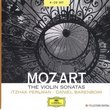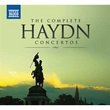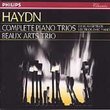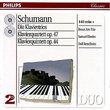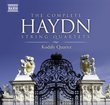| All Artists: Franz Joseph Haydn, Van Swieten Trio Title: Haydn: Piano Trios (Complete) [Box Set] Members Wishing: 0 Total Copies: 0 Label: Brilliant Classics Release Date: 1/24/2006 Album Type: Box set Genre: Classical Styles: Chamber Music, Forms & Genres, Concertos, Historical Periods, Classical (c.1770-1830) Number of Discs: 10 SwapaCD Credits: 10 UPC: 675754878221 |
Search - Franz Joseph Haydn, Van Swieten Trio :: Haydn: Piano Trios (Complete) [Box Set]
![Haydn: Piano Trios (Complete) [Box Set]](https://nationalbookswap.com/cd//l/62/3962/6133962.jpg) | Franz Joseph Haydn, Van Swieten Trio Haydn: Piano Trios (Complete) [Box Set] Genre: Classical
|
Larger Image |
CD DetailsSimilar CDs |
CD ReviewsDO WE UNDERSTAND HAYDN EVEN YET? DAVID BRYSON | Glossop Derbyshire England | 10/09/2006 (5 out of 5 stars) "In a letter Brahms says something to the effect `Nobody seems to understand Haydn nowadays. For years he gave us all our music'. Whatever precisely Brahms meant, it seems to me that the complete transformation in the idiom of music that made the music of Mozart and everyone since so astoundingly different from the music of Bach was Haydn's achievement, and his alone. Relics of the baroque manner are absent from Haydn's own style virtually from the outset. Any that remain relate to his treatment of the bass in ensembles, and that matter has a particular bearing on Haydn's piano trios, not so much in themselves as in the way they are perceived. Assuming for the moment what I shall try to explain in that respect, the set under review will be hard to surpass as `record of the decade' whatever marvels await us between now and the end of 2010. For comprehension of Haydn's style and its development, for loving, inspired and meticulous musicianship, for the ability to recognise and convey greatness when they find it, these artists deserve the most extravagant praise. For quality in the recorded sound, for thought and imagination in the production, for helpful and illuminating comment, and for sheer brilliant value, this set deserves hardly less. It comes compactly packaged in ten numbered envelopes averaging an hour's music apiece. Box and envelopes are of strong cardboard, but the discs can be difficult to extract when new, so be careful with them. There are 40 trios plus (on disc 5) a selection of individual movements where the music is probably by Haydn but the arrangements for trio not. Attribution to Haydn is probably not completely certain in some of the earliest trios either, but he becomes unmistakable before long, and none of the music is less than attractive. The 3 trios on disc 6 have flute rather than violin according to Haydn's expressed preference, and Marion Moonen uses a wooden flute. There are two violinists and two cellists sharing the work, but the fortepianos (several are used) are played throughout the entire 10 hours of music by the formidable Bart van Oort, who contributes one of the admirable liner-notes into the bargain. The level of musical insight shown by the entire ensemble I have already alluded to, but van Oort is a player to hear just for his playing, turning out trills to rival Gould himself. Serkin said that that Haydn's trios are a musical corpus to rival Mozart's piano concertos, and that a life devoted to their study alone would be well spent. He might have recorded some of them in that case, mightn't he? The statement is not much of an exaggeration in my opinion. Broadly speaking, one senses Haydn's style developing as the 10 discs progress, the adagio of the F# minor trio on disc 9 is better known as the sublime slow movement of the wonderful symphony 102, and the 4 trios occupying the last disc, particularly the C major, are absolute belters worthy to stand with the greatest of his piano sonatas. One can probably enjoy them best without reading too much about them, as enlightenment is in short supply in what one reads. Tovey finds `strange inability to refrain from writing down in the piano part everything that the other instruments have to say.' This I quote to illustrate the pitfalls of dealing in generalisation. There is more doubling between the violin and the piano's right hand than in later styles, but as a general characterisation of what you can hear with your own ears it is nonsense. The really interesting issue concerns the cello. Genuine emancipation of the cello in ensembles with piano came only with Mozart, although Haydn had got there in his quartets and symphonies. We may therefore choose to believe, as Tovey seems to, that this composer, the most thoroughgoing revolutionary, in his civilised way, that music has yet seen, was incapable of advancing in his trios to the treatment of the cello that he had achieved elsewhere; or we can believe something more probable. Cellists of the calibre necessary for Haydn's symphonies and quartets were probably still thin on the ground. The instrument never had music worthy of it until Bach, inspired by the playing of Linike, wrote his cello suites. In Haydn's time, as in Bach's, it was probably still embraced by players of little attainment or promise, and simple cello parts in piano `trios' were a way of giving such performers an opportunity to participate with their more gifted colleagues. It would take little to arrange Haydn's trios as `violin sonatas', but it seems to me that Haydn - or you or I come to that - can perceive the benefit of cello sound to the overall effect, even if Professor Tovey does not. The one thing I miss from this wonderful set is a clear account of the dates of the trios. I am not conversant with the Hoboken numbering-system, but it is not followed strictly here. Roughly, I would guess that the sequence of the works over these 10 discs follows the sequence of their composition. However there may be producer's or presentational reasons for departing from such rigid ordering, although I can't imagine any such reason for presenting the 3 flute trios, all on the same disc, in the (Hoboken) sequence 16/15/17. You may be aware that Haydn also wrote trios for baryton viola and cello, of which I own a marvellous complete set on vinyl, not now available on cd so far as I know, but there seem to be others of comparable quality. Those could well be another treat if you are unfamiliar with this side of the master's output. In the short term, there are these trios to get acquainted with if we thought we knew Haydn but were actually missing something important. Brilliant Classics indeed." Outstanding M. Bauer | Colorado | 01/29/2007 (5 out of 5 stars) "I can't add much to David Bryson's excellent review below. I've owned the Beaux Arts modern instrument set of these works for years, and I have to say I greatly prefer this set, which was performed on period instruments. I enjoy modern instrument performances of music from this period (for instance Mozart's piano concertos, where a period fortepiano is frequently overwhelmed by the orchestra, even a period insturment orchestra. However, I think period fortepianos are preferable in chamber music. The balance and clarity of these recordings is superb. Three different period fortepianos are used, adding to the sense of progression not just in Haydn's compositions, but also the color and texture of the music as influenced by the choice of instrument. As usual, Brilliant Classics offers a great value for the money as well. Informative liner notes, sturdy cardboard sleeves for each of the ten discs, and the set takes up less than two inches of shelf space. Highest of recommendations." Best available version Dale Matcheck | michigan | 02/09/2007 (5 out of 5 stars) "I normally prefer modern instruments in most recordings,even in Haydn's piano sonatas. But when it comes to Haydn's trios, I prefer the period instruments by far. They just seem to blend better, and the musicians seem to be able to play with more passion and energy; by contrast, the performances by the Beaux Arts Trio sound cold and restrained. Great recordings, and the price is amazing!"
|

 Track Listings (12) - Disc #1
Track Listings (12) - Disc #1